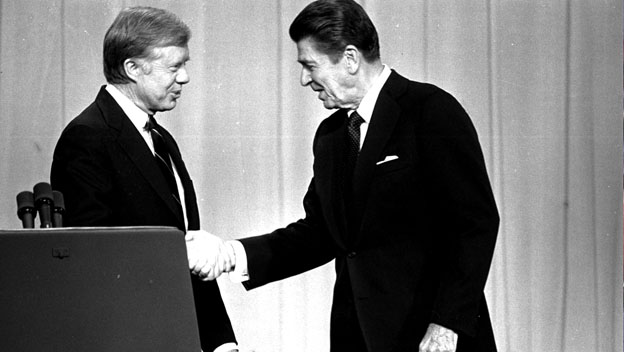A Brief History of Presidential Debates
Presidential candidates have not always debated one another in public, let alone in front of a television audience. It was not common for presidential candidates to be in one place during most of American presidential campaign history. One prominent exception was the 1858 Lincoln-Douglas Debates; Abraham Lincoln and Stephen A. Douglas were running against each other to represent Illinois in the U.S. Senate at the time, although they did oppose each other in the 1860 presidential election as well. Much more common were speeches on the stump, usually to friendly crowds. People who did not attend such events found out what presidential candidates prioritized and would do if elected by doing their own research or by reading newspapers (and, later, by listening to the radio and watching television). The 1948 Republican Party primary campaign featured a radio debate between Harold Stassen and eventual nominee Thomas Dewey. The two candidates engaged in opening statements and rebuttals, all on the same issue, of outlawing the Communist Party in America. The 1956 Democratic Party primary campaign featured a televised debate between eventual nominee Adlai Stevenson and Estes Kefauver, who ended up being Stevenson’s running mate. This debate focused on policy, foreign and domestic. The candidates gave opening and closing statements but also answered questions from a moderator, a member of the national television media.  The first televised general election debates took place in 1960. Then-Vice President Richard Nixon and then-Senator John F. Kennedy faced in a series of four debates that were televised and also broadcast on radio. The first debate, which took place in September 26, 1960, is thought to have set the tone for the rest of that election campaign. Candidates in the next three presidential election campaigns showed little interest in televised debates. The Democratic Party carried in with debates between candidates during the primaries, with Robert F. Kennedy and Eugene McCarthy squaring off in 1968 and Hubert Humphrey and eventual nominee George McGovern facing each other in 1972.
From that election forward, the practice of the presidential candidates from the two leading political parties has been the norm. A few exceptions to that formula were these: The 1980 campaign featured two debates, one between incumbent President Jimmy Carter and his Republican challenger, Ronald Reagan (above right), and the other between Reagan and John Anderson, an independent candidate who ran a high-profile campaign.
A debate featuring only the vice-presidential candidates became the norm with the 1984 campaign. In that year, incumbent George Bush faced off in a televised debate with the first female vice-presidential candidate, Geraldine Ferraro.
Formats of presidential debates have varied through the years. The most popular format is a series of speeches by the candidates, at times with rebuttals, as more resembles a proper debate. Another popular format in recent years is the “town hall” debate (left), which features candidates answering questions from audience members. Most televised debates have featured candidates standing behind podiums. Sometimes, however, the candidates have been seated at a table. And in some debates, notably the “town hall” ones, the candidates have roamed around the auditorium. |
|
Social Studies for Kids
copyright 2002–2024
David White



 It wasn’t until 1976 that the practice of general election campaign debates. resumed. Incumbent President
It wasn’t until 1976 that the practice of general election campaign debates. resumed. Incumbent President  The 1992 campaign featured three debates between incumbent President George Bush and his Democratic challenger, Bill Clinton, and they were joined on stage by the high-profile independent candidate Ross Perot (left). The vice-presidential debate also featured three candidates: Incumnnet Vice-president Dan Quayle, Democrat Al Gore, and independent James Stockdale, a former Vice Admiral of the Navy.
The 1992 campaign featured three debates between incumbent President George Bush and his Democratic challenger, Bill Clinton, and they were joined on stage by the high-profile independent candidate Ross Perot (left). The vice-presidential debate also featured three candidates: Incumnnet Vice-president Dan Quayle, Democrat Al Gore, and independent James Stockdale, a former Vice Admiral of the Navy. The League of Women Voters stopped sponsoring presidential debates after the 1988 campaign. These days, the Democratic Party and the Republican Party together organize the debates through the Commission on Presidential Debates.
The League of Women Voters stopped sponsoring presidential debates after the 1988 campaign. These days, the Democratic Party and the Republican Party together organize the debates through the Commission on Presidential Debates.
